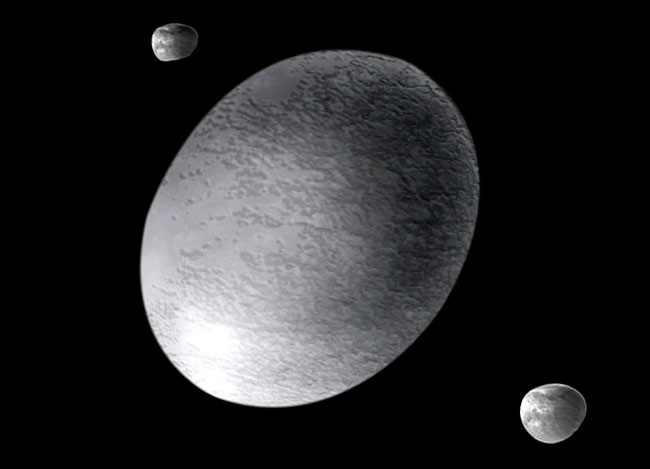Dwarf Planet Named for Hawaiian Goddess

Pluto and its dwarf planet brethren have a new friend.
The International Astronomical Union (IAU) announced the name of a new dwarf planet to join the existing four in the solar system.
The object previously known as 2003 EL61 is now named Haumea, after the goddess of childbirth and fertility in Hawaiian mythology. The name was decided by members of the International Astronomical Union's Committee on Small Body Nomenclature and the IAU Working Group for Planetary System Nomenclature.
The discovery of the odd, football-shaped Haumea was first announced in 2005. It was found by a group led by Jose-Luis Ortiz of the Sierra Nevada Observatory in Spain, as well as a team led by Mike Brown of Caltech, who was also behind the discovery of the dwarf planet Eris.
Brown and his team initially spotted the dwarf planet in December 2004 just after Christmas, leading them to nickname it "Santa"due to the then-holiday season, the planet hunter wrote in a blog entry this week. The new name was suggested by co-discoverer David Rabinowitz of Yale University, who believed it particularly apt since the goddess Haumea also represents the element stone and observations of 2003 EL61 found it to be composed almost entirely of rock with a pure ice crust, Brown added.
Haumea joins Ceres, Pluto, Eris and Makemake as the fifth dwarf planet in our solar system. Pluto was re-classified from planet to dwarf planet in 2006,following the discovery of Eris.
The new dwarf planet has the same diameter as Pluto, but is much thinner, and contains about 32 percent of Pluto's mass. Scientists suggest Haumea's long, narrow shape arose from its rapid spin ? it rotates about once every four hours.
Get the Space.com Newsletter
Breaking space news, the latest updates on rocket launches, skywatching events and more!
Haumea is currently about 50 times as far from the sun as Earth is, but its orbit can swing it in as close as 35 times the sun-Earth distance. It is part of the trans-Neptunian class of cold and rocky objects inthe outer solar system.
Two small companion objects, thought to have been knockedoff Haumea's body by past impacts, keep the dwarf planet company. The two moons were also re-designated with new names: Hi'iaka and Namaka, after the two children born to the goddess Haumea in Hawaiian myth. In the story, Haumea's children were created out of parts of her own body, just as the dwarf planet's two moons were apparently born out of itself.
Join our Space Forums to keep talking space on the latest missions, night sky and more! And if you have a news tip, correction or comment, let us know at: community@space.com.

Clara Moskowitz is a science and space writer who joined the Space.com team in 2008 and served as Assistant Managing Editor from 2011 to 2013. Clara has a bachelor's degree in astronomy and physics from Wesleyan University, and a graduate certificate in science writing from the University of California, Santa Cruz. She covers everything from astronomy to human spaceflight and once aced a NASTAR suborbital spaceflight training program for space missions. Clara is currently Associate Editor of Scientific American. To see her latest project is, follow Clara on Twitter.










